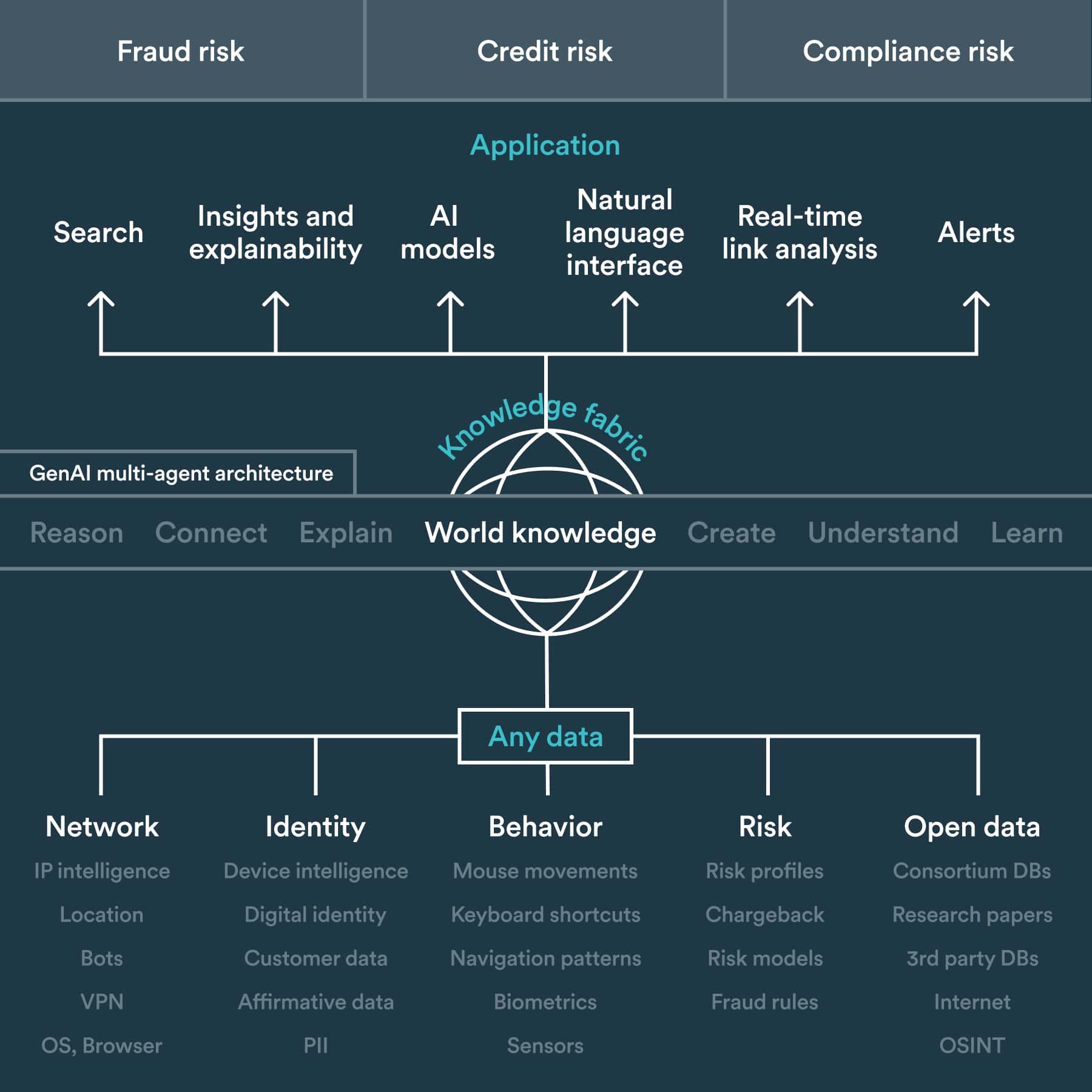Oscilar unveils the first-ever generative AI vision for risk decisioning
In our technology-driven world, apps and websites have become custodians of valuable financial, personal, and health data. And while this means a more convenient user experience, it also comes with serious risk: fraud – fueled by the vast digital attack surface, advanced technology, and organized networks on the anonymous internet. Synthetic identities, scams, deep fakes, account takeover attacks, first party fraud, bots, and increasing online payment fraud are among the top trends plaguing businesses today, resulting in substantial financial losses.
Unfortunately, current risk tools fall short in addressing these fraud challenges – relying on siloed data and jerry rigged point solutions, demanding vast engineering and data science resources, leaving ample room for human error, and still not effectively solving the root problem. Businesses must balance all of this while also ensuring exceptional customer experiences.
We formed Oscilar more than two years ago to tackle fraud and risk, working with some of the top engineering, data science, and AI talent in the world. In March, we publicly launched the company and our no-code AI risk decisioning platform to dozens of fintech and financial institution customers.
Since we launched Oscilar, there have been rapid advances in the field of generative AI. These advances will completely change the foundation of how we protect online transactions. Generative AI will create a new category of solutions for risk management – AI Risk Decisioning.
Our team has been quietly building a new AI Risk Decisioning offering powered by generative AI. Today, we want to share more about our expanded vision for Oscilar and the AI Risk Decisioning category – providing more insight into what it is, why it’s needed, and how it will change the game for our customers.
AI Risk Decisioning: A new foundation for fraud and risk management
AI Risk Decisioning will harness a natural language interface, real-time AI capabilities, and cutting-edge generative AI advancements. We are building Oscilar from the ground up on this AI Risk Decisioning foundation.
With AI Risk Decisioning, Oscilar will be different from current fraud and risk tools because it will scour data from the most comprehensive open and closed sources, build fraud knowledge on top of it, and use AI to bring this information together in a unified way. As a result, Oscilar, equipped with context-aware conversational AI, will automatically recognize potential fraud patterns, and make recommendations on how to resolve threats in real-time through a natural language interface.
Once implemented, businesses will be able to radically expedite risk decision-making, greatly reduce human effort spent on manual decision-making, and establish scalable fraud programs that operate with greater efficiency and effectiveness.
AI Risk Decisioning represents a fundamental shift in the six foundational pillars of risk management — how we know, how you ask, how we recommend, how we understand and explain, how we guide, and how we automate.
By integrating Oscilar’s AI capabilities, state-of-the-art LLMs, and our Risk Operating System, this enhanced version of Oscilar will empower risk operators to tackle complex fraud and risk problems at scale from multiple dimensions.
Here are the pillars of AI Risk Decisioning and the foundation for our future version of Oscilar:
1. A 360° knowledge fabric – 'How we know'
With AI Risk Decisioning, Oscilar will further distinguish itself in risk management because we will provide risk operators with a unified open data and knowledge fabric. Our platform will integrate data from multiple internal sources (including real-time and historic transaction records and customer profiles) and external sources (including OSINT data repositories, consortium databases, AI research, industry reports, and academic publications). Notably, customer data will solely remain with Oscilar and will not be employed to train any third-party AI models. This approach underscores our commitment to data privacy and security.
By building this knowledge fabric, Oscilar will offer a cognitive core for risk management. This will equip risk operations with the intelligence needed to comprehend diverse risk vectors and make well-informed decisions based on a holistic understanding of the risks associated with each customer and transaction. By harnessing the contextual understanding provided by the knowledge fabric, companies can accelerate fraud investigations and response times by up to 10X, enabling swift action and enhanced protection against fraudulent activities.
For instance, companies (and consumers) are increasingly vulnerable to “synthetic payment fraud,” whereby fraudsters use AI-generated synthetic identities and manipulated transaction data to execute sophisticated payments fraud and money laundering schemes. Fraudsters create fictitious payment accounts that disguise illicit funds as legitimate transactions. These synthetic identities closely mimic real customers, making it difficult for traditional ML models to differentiate between legitimate and fraudulent transactions because traditional ML models rely on historical data, are unable to recognize the new fraud pattern, and lack sufficient training data to keep up with the evolving and increasingly sophisticated schemes.
However, by implementing AI Risk Decisioning, Oscilar's knowledge fabric will leverage Generative AI to analyze vast amounts of unstructured data and recognize emerging patterns. This will allow it to identify anomalies in transaction behavior and detect the subtle characteristics of synthetic identities. By integrating both traditional ML and generative AI, continuously updating its models, and learning from real-time data, Oscilar will effectively combat this type of payment fraud and money laundering.
2. A natural language interface – 'How you ask'
With AI Risk Decisioning, Oscilar's natural language interface will radically simplify risk management tasks. Risk operators will be able to create customized workflows, rules, models, and integrations without coding expertise. And risk operators can explain their requirements in natural language. This removes the need for risk operators to work through data scientists or engineering teams in order to understand the tech side of risk management. In its place, risk operators can communicate their needs and make informed decisions based on comprehensive insights, regardless of their understanding of the necessary data or analytical skills.
For example, when Oscilar's natural language co-pilot interface launches, risk operators will be able to create a risk model to identify account takeover attacks by describing the risk model in plain language. They can optionally specify criteria such as detecting suspicious login behavior, unfamiliar IP addresses or geo-locations, signs of bot activity, and deviations from the user's typical login patterns.
The co-pilot interface will translate this description into the corresponding risk models and workflows, streamlining the process that would have taken days or weeks to complete. With the co-pilot's assistance, risk operators will be able to create, test, deploy, and monitor the performance of such risk models within a matter of hours, saving time and resources.
3. Auto recommendations – 'How we recommend'
AI Risk Decisioning’s capabilities will provide risk operators with proactive and automatic recommendations for effective risk mitigation. We will do this by automating rules and model generation, auto-monitoring transactions, suggesting relevant features for risk models, conducting what-if analysis, and recommending the next best action to optimize performance and growth.
Imagine Oscilar identifying a new "Synthetic Identity Fraud" scheme. Automatically learning its unique characteristics, Oscilar would create a specialized AI model. This model would be built using key features including anomaly detection in application data, velocity of credit applications, associations with high-risk entities, and behavior analysis such as intent, familiarity, and device profile.
Using an advanced machine learning model, Oscilar would accurately detect complex patterns and anomalies. Risk operators, after reviewing and approving the model's performance, would activate it to proactively guard against this fraud. This approach, which significantly enhances the overall risk management strategy, not only results in substantial cost savings but also fortifies the security of both customers and the business.
4. Human-understandable reasoning — 'How we understand and explain'
One of the integral aspects of AI Risk Decisioning is the ability to comprehend the 'why' and 'how' behind every AI-driven decision, recommendation, investigation, and insight.
With AI Risk Decisioning, risk operators are empowered to not only inquire about but also understand the key factors that influence risk assessments. It aids them in detecting emerging fraud patterns, developing robust defenses against them, and succinctly articulating fraud trends and performance metrics to the team.
To illustrate, let's consider a scenario where a fintech organization's monthly fraud performance report reveals a sudden 12% increase in fraud chargebacks, accompanied by a significant surge in false positives tied to the launch of a new credit card. In such a situation, Oscilar’s AI Risk Decisioning powered platform would automatically initiate an exhaustive root cause analysis. The platform would provide a transparent rationale for the risk factors affecting the chargeback rate, thoroughly examining changes in customer segmentation, application behavior, distinctive transaction patterns, and the effectiveness of individual risk models and rules.
This comprehensive analysis allows risk operators to discern contributing factors. These might include shifts in customer spending habits or the emergence of fraudulent tactics that exploit the new credit card application process. This level of insight equips risk operators with the understanding necessary to confidently explain the underlying reasons for the observed trends to stakeholders, thereby facilitating effective risk mitigation.
5. Augment Risk Experts – 'How we guide'
AI Risk Decisioning will function as an aide to risk operators, offering real-time intelligence, specialized knowledge, and contextual data to refine their decision-making process. Rather than being inundated with numerous alerts and notifications, risk operators will depend on Oscilar for efficient alert management.
Using Oscilar's intuitive natural language interface, risk operators will attain comprehensive case information encompassing aspects like entity relationships, customer history, fraud classification, mode decision, trust and risk indicators, and explainability for high-risk scenarios. This exhaustive perspective will empower risk operators to not only neutralize immediate fraudulent activities but also identify and tackle associated fraudulent cases on a larger scale that may have previously gone undetected.
For instance, when Oscilar’s AI Risk Decisioning powered products launch, a risk operator could enlist Oscilar's expertise in examining a series of questionable ACH transactions, and Oscilar would undertake an analysis of the transaction data, revealing a complex series of irregularities. These irregularities might encompass a lack of prior connection between the beneficiary and the customer, exceptionally high transaction values, unusual timing of transactions, unfamiliar device or browser usage, rapid geographical shifts, and/or inconsistencies between IP addresses and geolocations.
In this scenario – given the urgency – Oscilar would advise on blocking these transactions and investigating the associated entities. This approach would advance additional similar instances exhibiting the same irregularities.
6. Risk automation – 'How we automate'
Once Oscilar’s AI Risk Decisioning powered products launch, they will automate time consuming and repetitive tasks in fraud analysis, performance review, and compliance checks. With a simple click, risk operators will access reports on fraud trends, alert summaries, performance metrics, and visual stories for performance reviews. This automation will reduce the time to compile any monthly fraud trends and performance reports from days to less than an hour.
What this means for the future of risk management
In the era of digitization, where our most valuable assets and information are safeguarded behind digital walls, we must overhaul our risk management approach. The outdated and siloed risk prevention tools have struggled to keep pace with the evolving, sophisticated threats our digital world faces. This is where Oscilar and our revolutionary AI Risk Decisioning approach steps in.
By implementing Oscilar's new AI Risk Decisioning powered products – available as early as this fall -- businesses will be able to significantly accelerate their decision-making process around risks, streamline their risk management operations, and efficiently combat fraud threats. With AI Risk Decisioning, we’re not just changing risk management. We’re transforming the field altogether, ensuring a future where businesses can operate with confidence and security in the digital realm. Join us on this journey as we revolutionize risk management and take a bold step towards making the internet safer.



